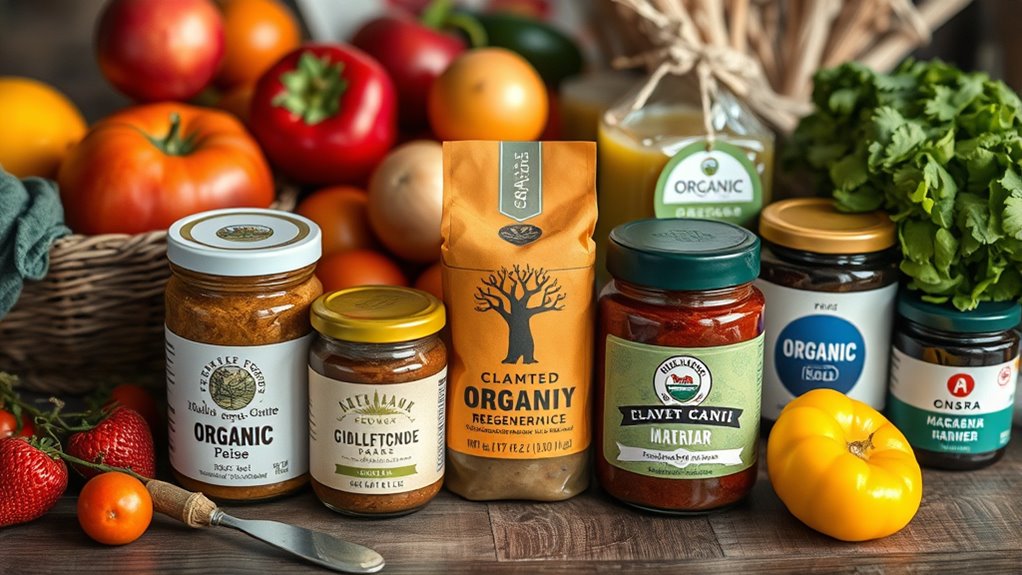Food labels like organic, regenerative, and local help you pick healthier, more sustainable options. Organic foods are produced without synthetic chemicals and support soil health. Regenerative labels focus on improving land and biodiversity with farming practices that rebuild ecosystems. Local labels indicate food from nearby farms, reducing environmental impact and ensuring freshness. Understanding these labels helps you make mindful choices that benefit your health and the planet. Keep exploring to learn more about what they really mean.
Key Takeaways
- Organic labels indicate food produced without synthetic chemicals, emphasizing natural methods and environmental sustainability.
- Regenerative farming focuses on actively improving land health through practices like cover cropping and composting, enhancing soil and ecosystem vitality.
- Local food labels identify products sourced from nearby farms, reducing transportation emissions and supporting community economies.
- Organic and regenerative practices promote soil health, biodiversity, and long-term sustainability, often resulting in more nutrient-dense foods.
- Local labels foster transparency and freshness by connecting consumers directly with nearby producers and their farming methods.

Understanding food labels is essential for making informed choices about what you eat. When you glance at a package, you want to know what’s behind those claims—whether it’s organic, regenerative, or local. These labels aren’t just marketing tricks; they reflect different farming practices and philosophies that can impact your health, the environment, and the community. Recognizing what each label means helps you support sustainable farming methods and align your choices with your values.
Organic labels indicate that the food was produced without synthetic pesticides, fertilizers, or genetically modified organisms. Organic farming emphasizes soil health, biodiversity, and animal welfare, which often results in fresher, more nutrient-dense products. When you see an organic label, you’re choosing food that’s grown with an eye toward sustainability, reducing chemical inputs, and promoting healthier ecosystems. This label also guides you through dietary labels, helping you avoid potentially harmful substances and opt for cleaner, more natural options. As a consumer, understanding these labels empowers you to support farming practices that prioritize environmental health and long-term sustainability.
Organic labels mean food is produced without synthetic chemicals, supporting sustainability, soil health, and nutrient-rich, natural products.
Regenerative farming takes the concept of sustainable agriculture a step further. It’s not just about avoiding harm but actively improving the land with every crop or animal raised. Regenerative farms often use practices like cover cropping, rotational grazing, and composting to rebuild soil vitality, increase biodiversity, and sequester carbon. When you see regenerative labels, they signal that the food you’re buying comes from farms committed to restoring ecosystems and creating resilient landscapes. Additionally, regenerative practices often involve building soil health, which enhances the land’s capacity to sustain healthy crops and livestock over time. This approach aligns with your desire to support a more sustainable food system that benefits not only the environment but also local communities and future generations.
Local labels point to food sourced from nearby farms and producers, often within a certain radius of where you live. Shopping local reduces the carbon footprint associated with transportation and supports local economies. Local food can be fresher because it doesn’t have to travel long distances, and it often involves smaller-scale, transparent farming practices. When you choose local, you’re making a conscious decision to strengthen your community and promote sustainable farming methods practiced by nearby farmers. These labels also help you navigate dietary choices by giving you insight into the origin of your food, fostering a deeper connection between you and the people who grow what you eat.
In essence, understanding these labels allows you to make more intentional choices. Whether it’s supporting sustainable farming practices through organic and regenerative labels or choosing local foods to reduce environmental impact, being informed helps you align your shopping habits with your values. Every label tells a story about the journey from farm to table, and by paying attention, you can contribute to a healthier planet and a more transparent, sustainable food system.
Frequently Asked Questions
How Can I Verify a Food Label’s Authenticity?
You can verify a food label’s authenticity by checking for certification standards from reputable organizations like USDA Organic or Non-GMO Project. Always look for official seals and verify them on the certifier’s website. Be cautious of label fraud—some products may falsely claim organic or regenerative status. Research the brand and ask questions if you’re unsure. This way, you guarantee you’re buying genuinely certified and trustworthy products.
Are Organic Labels Strictly Regulated Worldwide?
Imagine it’s 2024, and organic labels aren’t the Wild West. You can trust that they’re regulated, but standards vary worldwide. Countries have strict labeling standards and certification processes to guarantee authenticity. In the US, the USDA oversees organic certification, while Europe has its own standards. Always check for official seals, as these certifications verify the authenticity of organic claims, giving you peace of mind wherever you shop.
What Distinguishes Regenerative Agriculture From Traditional Farming?
Regenerative agriculture differs from traditional farming by actively improving soil health through practices like cover cropping, crop rotation, and reduced tillage. You focus on enhancing soil vitality, which boosts biodiversity and captures carbon. Unlike conventional methods, regenerative farming emphasizes crop diversity, resilience, and sustainability, aiming to restore ecosystems rather than deplete them. By adopting these techniques, you create a more sustainable system that benefits the environment and your crops long-term.
How Does Local Food Labeling Vary Between Regions?
You might think local food labeling is uniform, but regional labeling standards vary widely due to cultural influences and local regulations. In some areas, labels emphasize farm practices or community support, while others highlight freshness or seasonality. These differences reflect local values and priorities, so when you see a label, know it’s shaped by regional standards. This variation helps you make more informed choices aligned with your community’s unique agricultural identity.
Can a Product Be Both Organic and Regenerative?
Yes, a product can be both organic and regenerative. Organic farming focuses on avoiding synthetic chemicals and promoting soil health, while regenerative farming goes further by actively restoring ecosystems and enhancing soil quality through sustainable practices. When a farm adopts both labels, you’re getting produce that supports sustainable farming, improves soil health, and reduces environmental impact. It’s a powerful way to choose foods aligned with eco-friendly principles.
Conclusion
So, next time you pick up your groceries, remember these labels aren’t just labels—they’re stories about your food’s journey. Whether it’s organic, regenerative, or local, each choice supports a healthier planet and community. Don’t let the age of your food define it—choose wisely, like a knight of old seeking the purest fruit of the land. Your mindful decision today can help craft a better tomorrow, one delicious bite at a time.








